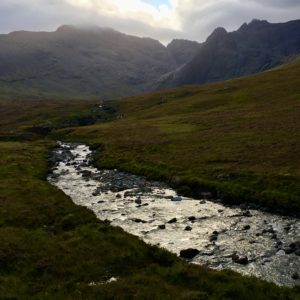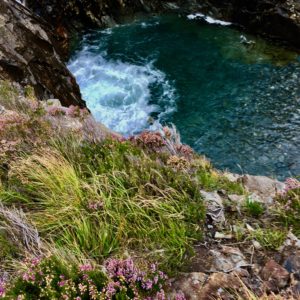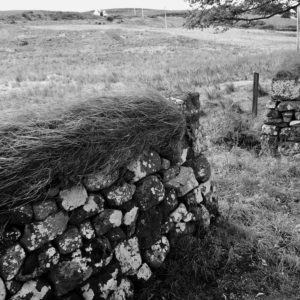From the Isle of Skye
At 57 degrees latitude the Isle of Sky, the largest of Scotland’s Hebrides Islands, lies considerably further north than Seattle, which is at 47 degrees latitude.
 So while the climate bears some resemblance to our own coastal temperate one, Skye itself looks more far more rugged and barren, though in a dramatic and beautiful sort of way. There are vast expanses of open lands and stony towering hills, covered with heather and gorse. Really very similar to the Scottish Highlands on the mainland. The photo here was taken today on a hike in Cuillin Mountains of central Skye. They are a famous destination for mountaineers and climbers.
So while the climate bears some resemblance to our own coastal temperate one, Skye itself looks more far more rugged and barren, though in a dramatic and beautiful sort of way. There are vast expanses of open lands and stony towering hills, covered with heather and gorse. Really very similar to the Scottish Highlands on the mainland. The photo here was taken today on a hike in Cuillin Mountains of central Skye. They are a famous destination for mountaineers and climbers.
Of Skye and its weather the venerable Dr. Johnson wrote, in his 1773 book A Journey to the Western Islands of Scotland, “The weather is not pleasing. Half the year is deluged with rain. From the autumnal to the vernal equinox, a dry day is hardly known, except when the showers are suspended by a tempest.”
But this has apparently been an unusually warm and sunny summer for Skye. Just now — in time for our visit — have the clouds and rain arrived. But really it has been beautiful, the kind of days where you have a sudden downpour followed by a sun break, racing clouds and rainbows.
At the world famous Talisker Distillery in Carbost, the only Scotch distillery on Skye, we learned that in fact the summers have been so unusually warm of late that the distillery slowed its draw of underground spring water on the island to avoid depleting it. No escaping climate change I guess.
 To the eye, there is a lot of water. Streams and waterfalls seem everywhere. Today’s hike was to the “Fairy Pools,” a series of deceptively still blue green pools at the foot of waterfalls stair-stepped down the hills. Here is photo of one such pool. Note the heather in the foreground.
To the eye, there is a lot of water. Streams and waterfalls seem everywhere. Today’s hike was to the “Fairy Pools,” a series of deceptively still blue green pools at the foot of waterfalls stair-stepped down the hills. Here is photo of one such pool. Note the heather in the foreground.
Apparently the first inhabitants of Skye were Vikings some 7,000 years ago. Some of the old Scottish families trace their lineage, at least in part, to Viking forebears, as do some of the place and proper names, like Talisker.
 One of our unplanned but particular beautiful stops today was at a cemetery overlooking Loch Sligachan. An older section of the cemetery was bounded by a beautiful stone wall, capped with wind manicured grasses. Here’s a black and white from there.
One of our unplanned but particular beautiful stops today was at a cemetery overlooking Loch Sligachan. An older section of the cemetery was bounded by a beautiful stone wall, capped with wind manicured grasses. Here’s a black and white from there.
These days Skye is a popular tourist destination for people from all over the world. Some come as part of “Whiskey Tour,” a swing through Scotland’s famous distilleries. Others come to hike, climb mountains or go mountain biking.
While we’ve seen some people biking the roads in Scotland, it isn’t anything I’d want to do. The roads are mostly very narrow two-lane affairs. Despite the twists and turns the Scots take them at 60 – 70 mph. Meanwhile, there’s a lorry (truck) bearing down on you in the oncoming lane, passing (you pray) just inches away. And there’s no shoulder at all to the other side to ease toward for comfort. Two narrow lanes. To the left, a drop-off to gravel ruts or a ditch. The Scots are, it seems, “scotch” when it comes to asphalt.
![Anthony B. Robinson [logo]](https://www.anthonybrobinson.com/wp-content/themes/anthonybrobinson/images/logo.png)
![Anthony B. Robinson [logo]](https://www.anthonybrobinson.com/wp-content/themes/anthonybrobinson/images/logo-print.png)